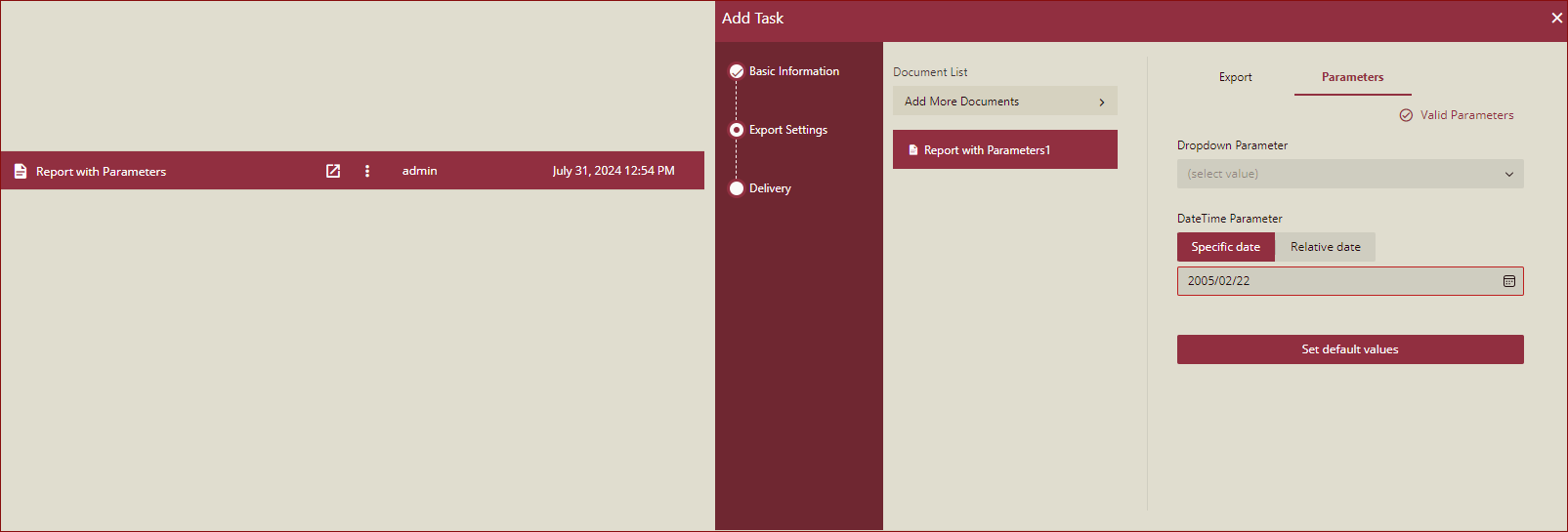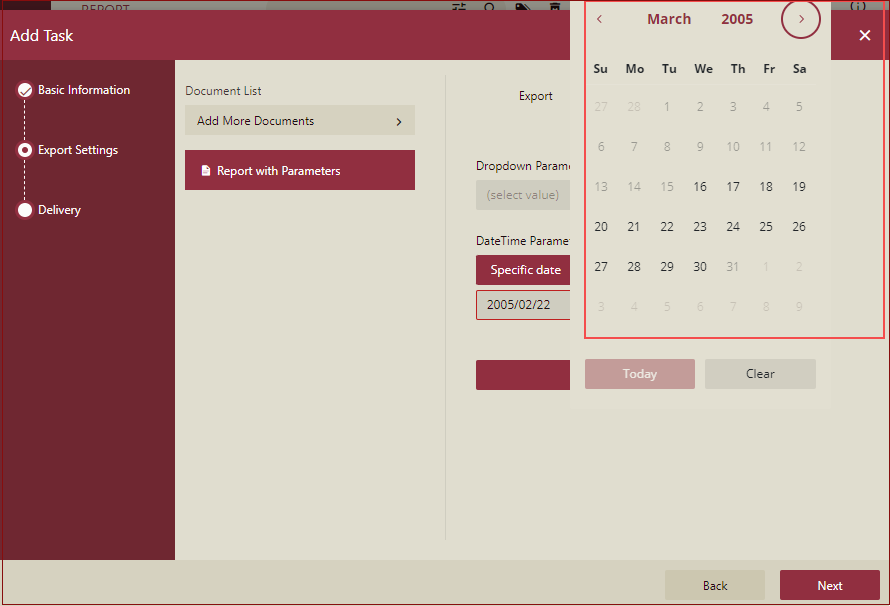- Getting Started
- Administration Guide
-
User Guide
- An Introduction to Wyn Enterprise
- Document Portal for End Users
- Data Governance and Modeling
- View and Manage Documents
- Working with Resources
- Working with Reports
- Working with Dashboards
- Working with Notebooks
- Wyn Analytical Expressions
- Section 508 Compliance
- Subscribe to RSS Feed for Wyn Builds Site
- Developer Guide
Create Custom Parameters View
The Parameters View can be designed in Report Designer using the exclusive set of controls to create and define parameters and prompts quickly. The controls include input controls like text editor, number editor, heading, and plain text; range editors like date range and date-time range; and list and dropdown editors.
On previewing the report, the customized parameters view is shown in the Parameter Panel of the viewer.
Design a Parameters View
In the Report Designer, add report parameter(s) and apply filters using parameter(s).
Go to the Parameters tab at the top of the report designer.
Create the custom parameters view for the report by clicking the Generate View button in the toolbar or clicking the Generate button in the center of the designer.
If the report already has pre-defined report parameters, a default parameters layout is generated in the design area from these parameters. You can then build the parameters view from the default view or simply create a fresh parameter view using the controls available in the parameters designer.
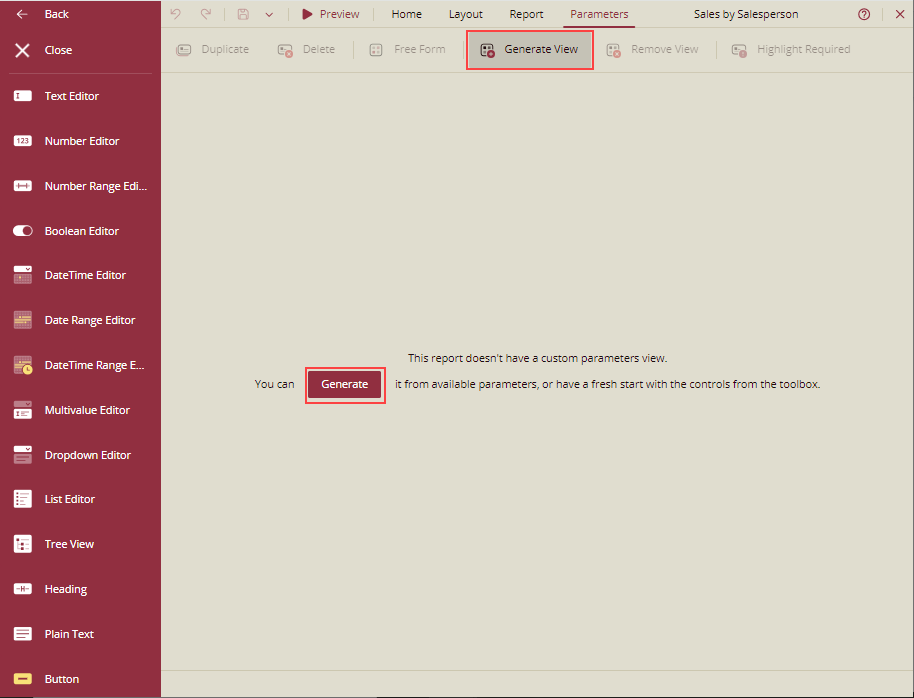
Drag and drop the controls from the toolbox onto the design area of the parameters view.
Bind parameters to controls using Binding property from the Inspector panel or from the red box in the control. The available parameters can be selected from the drop-down list.
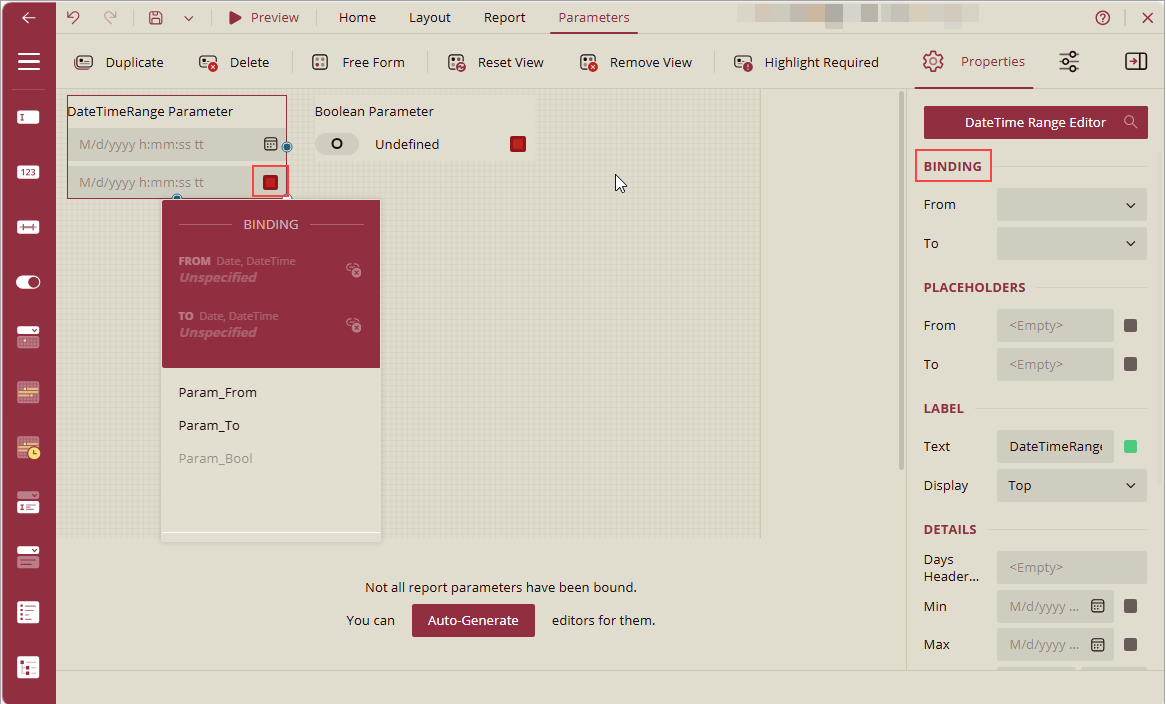
Set the properties of each of the controls, such as Binding, Label, etc., depending on the function of each control. See this section for common properties of controls available for designing parameters view.
Add buttons to preview the report based on selected parameters, reset the parameter selection to default, and clear the selection.
Parameters View Designer Properties
Use the Free Form/Stack switch to see how parameters will look in the preview window.
When the Free Form layout type is on, the view matches the current parameter view on the viewer's sidebar. The order of parameters can be changed by dragging the controls. You can also change the location and size of the controls.
When the Stack layout is on, the view arranges the controls vertically. The order of parameters can be changed by dragging the controls.
Use Reset View to reset to the default layout of the parameter view.
Choose the Highlight Required option to highlight the errors while designing the parameter view.
Controls Available for Designing a Parameters View
The controls provide an intuitive user experience with customization possibilities. The following is the list of controls available for designing a parameter view.
Text Editor: For single-line parameters of the String type.
Number Editor: For parameters of integer or float type. Set the control's type as Up-down Editor for increasing or decreasing at specified steps, or as Slider to be able to slide the value of the parameter.
Number Range Editor: For a parameter range of integer or float type. You need to specify the range in the From and To fields in Binding.
Boolean Editor: For parameters with the Boolean value. The Boolean editor can be a Toggle, a Checkbox, or a Radio button. As you change the type of the Boolean editor, the options can be filled in.
DateTime Editor: For parameters with date and date-time values.
Date Range Editor: For parameters with a date field. Specify the start date and end date in the From and To fields in Binding.
You can also add custom ranges manually using the Ranges property (Add > Edit) or select ranges from the pre-defined options in a dropdown menu (Current, Last, Next, ToDate, and LastToDate) for intervals (specified via the Unit property: Year, Quarter, Month, Week, etc.) Using the View Mode property, you can set the calendar's initial view to Default, Days, Months, or Years.
DateTime Range Editor: For parameters with a range of dates with an explicit starting and ending time. This editor has been introduced especially to work with date-time type parameters.
You can also add custom ranges manually using the Ranges property (Add > Edit) or select ranges from the pre-defined options in a dropdown menu (Current, Last, Next, ToDate, and LastToDate) for intervals (specified via the Unit property: Year, Quarter, Month, Week, etc.)
See section Add Custom Ranges in DateTime Range Editor for more information.
Multivalue Editor: For multi-value parameters whose values are required to be entered manually. It appears with a list of multiple values in the drop-down with the search box.
Dropdown Editor: A list of fields in the parameter appears in the drop-down with a search box. Single or multiple values can be selected depending on whether the Multi Value property is enabled or not.
List Editor: Fields bound to parameters appear as a list, with checkboxes to select the field.
Tree View: For hierarchical parameters. Select the Tree View type as List or Dropdown.
Heading: For static text, e.g., entering a heading with a choice of colors for error or warning.
Plain Text: For static text, eg., entering single or multiline text.
Button: To perform actions on the preview screen, select Preview to preview a report based on the selected parameters, Reset to reset the parameter selection to default, and Clear to clear the selection, on the preview window.
Note: You can set the width and height of the control as per your choice. For control Width, the default value is 200 and the minimum value is 30. For control Height, the default and minimum value is 30.
Common Properties of Controls for Designing Parameters View
Binding: Most parameters view controls need to be bound to parameters before they can be used. This property is used to bind parameters and is a basic property of parameter-type controls. Use Reset to unbind.
Placeholder: Used to set the placeholder content, displayed in the parameter box when no parameters are entered or selected. It supports the use of expressions, such as using user information context, calling language resources, or using custom functions. See this section for more information.
Label: Used to set the label text of the control title (Text) and its position (Display) relative to the control itself. The title text supports the use of expressions. When the display position is set to the left or right, you can adjust the "Width, %" property to set the distance between the control title and the control. You can directly enter the width value or drag it on the control to adjust it. The Heading, Plain Text, and Button controls do not support the Display property.
Location & Size: Left and Top are used to set the distance of the upper left corner of the control from the left and top of the canvas. Width and height are used to set the dimensions of the control.
Add Custom Ranges in DateTime Range Editor
In the Report Designer, add two report parameter(s) that define two points in the date time range. Note that the Data Type while defining these parameters must be 'DateTime'.
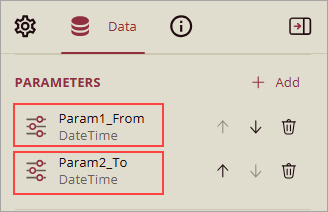
Apply filters in the report using parameter(s) as required.
Go to the Parameters tab at the top of the report designer and click the Generate button in the center of the designer.
In the Parameters View Designer, drag-and drop DateTime Range Editor control.
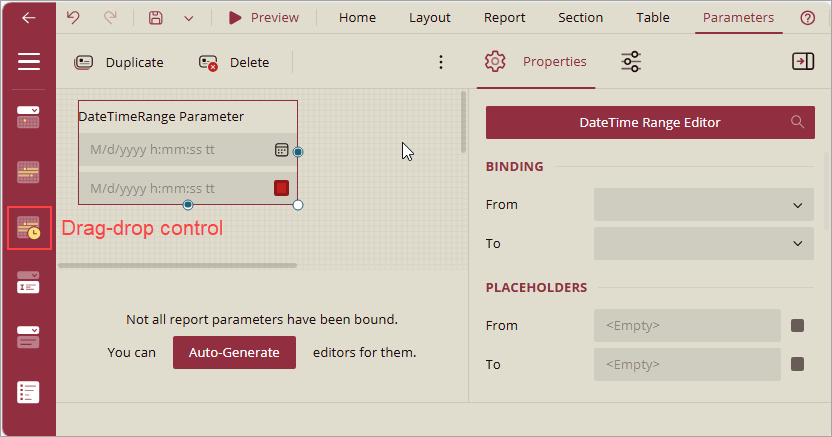
Set parameters under Binding > From and Binding > To properties.
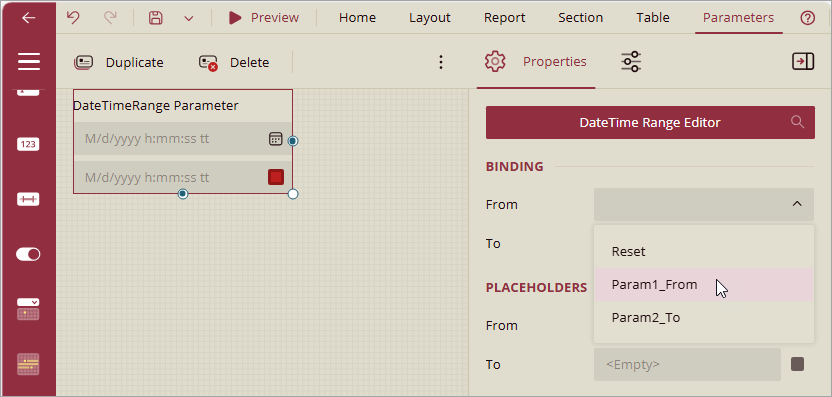
Set Label > Text and Label > Display to 'Select Date Time Range' and 'Top', respectively.
Set the Details > Min and Details > Max properties as explained in detail in section: Limiting the Range of Selectable Dates in Date Editors.
From Details > Ranges, let us add a custom range and set the following properties to display 2 days before the last day:
Set Unit to 'Day'
Set Range to 'Last'
Set Amount to '2'
Set Label as 'Last 2 days'
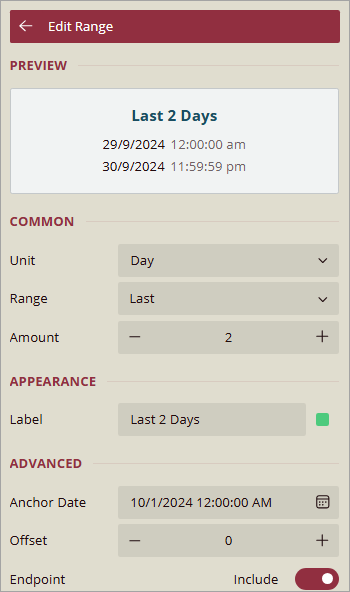
Preview the report. The viewer displays the Parameters panel as shown below.
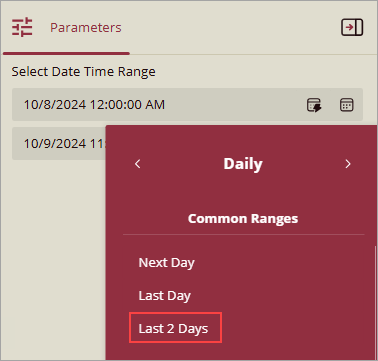
Using Expressions and User Functions in Custom Parameters View
You can internationalize the custom parameter view by displaying the content according to the user's location or language. It lets you create multilingual labels for custom parameter controls. It will display the labels in different languages, like English, Polish, Chinese simplified, etc., using a language resource file. For more details about language resources, refer to Add Language Resource.
You can use the expressions and user functions in the custom parameter panel to internationalize the labels.
Example 1: Internationalize the custom parameter label of the text editor by using a language resource file and the UserContext.T() function.
Follow the steps given below to internationalize the custom parameter label of the text editor.
Drag and drop the Text Editor. Use the Language Resource Files property in the Info panel to specify which resource documents you want to reference.
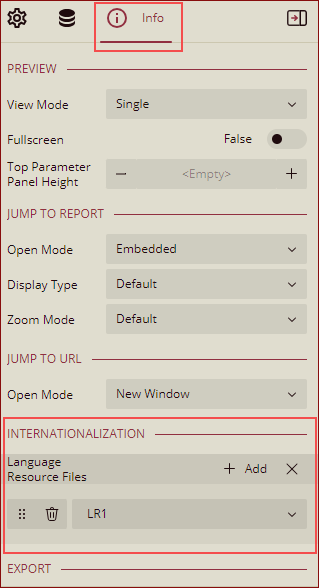
On the Parameter panel, bind the text editor control with the already defined parameter. We have already defined the parameter StringParameter() in this example. The Label property of the text editor supports the use of expressions. To change the label of the text editor to a Chinese simplified language by using the expression, click the Expression option as shown below.
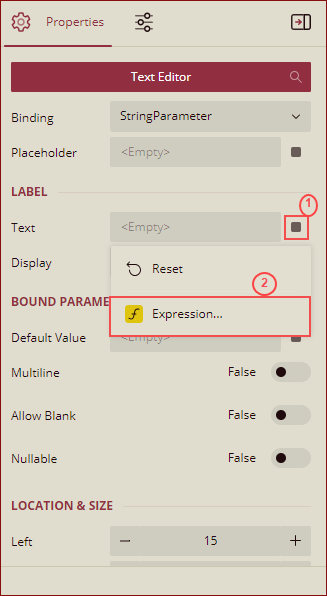
The Expression Editor dialog box will be displayed as shown below. Use the UserContext.T() function under Miscellaneous Functions. The UserContext.T() function displays the value for the specified translation key enclosed in double quotes. Enter the expression as per your requirements and click Save. For this example, we have defined a key as stringParamLabel in the language resource file.
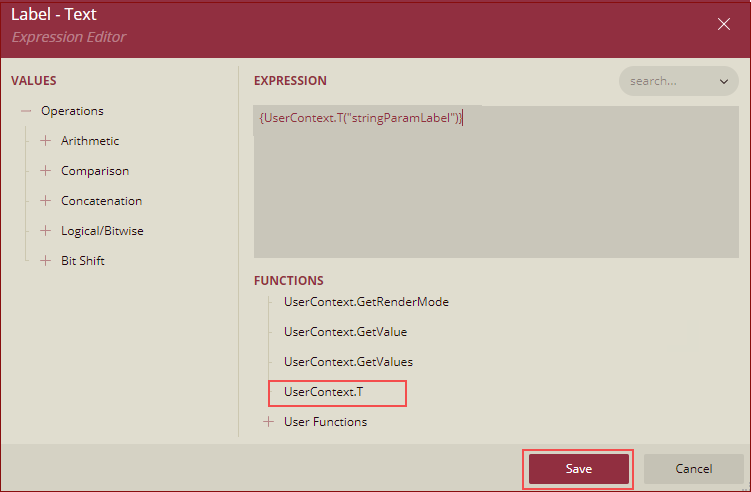
Add a Preview button.
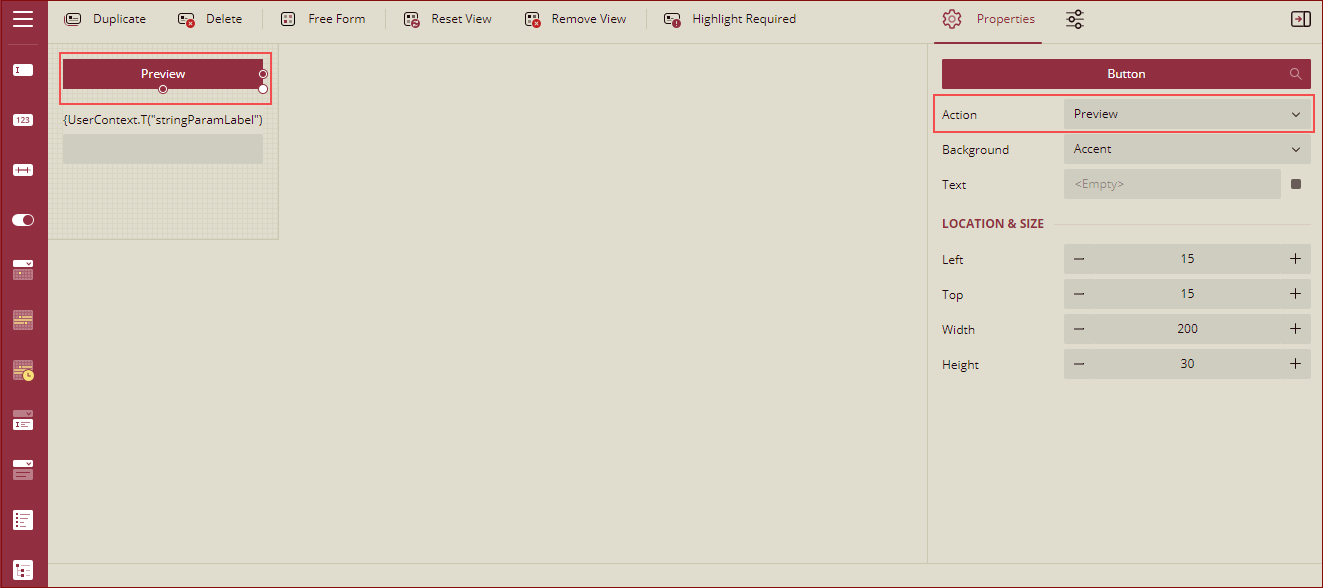
Preview for English Labels.

In the URL, change the language key to Chinese simplified language zh-cn as mentioned in the language resource. The labels will change to a Chinese simplified language as shown below.

Note: You can also use expressions for placeholders in custom number parameters and DateTime parameters. You can also utilize user functions specified in the Admin Portal as Code.FunctionName() in these expressions.
Example 2: Internationalize the placeholders in the datetime range editor by using a language resource file and the user function.
Follow the steps given below to internationalize the placeholders in the datetime range editor.
Drag and drop the DateTime Range Editor control. Use the Language Resource Files property in the Info panel to specify which resource documents you want to reference.
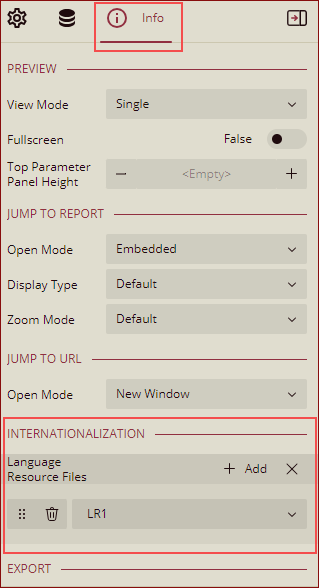
On the Parameter panel, bind the control with the already defined parameters. In this example, we have defined 2 parameters as Parameter 1 and Parameter 2. Click the Expression option as shown below.
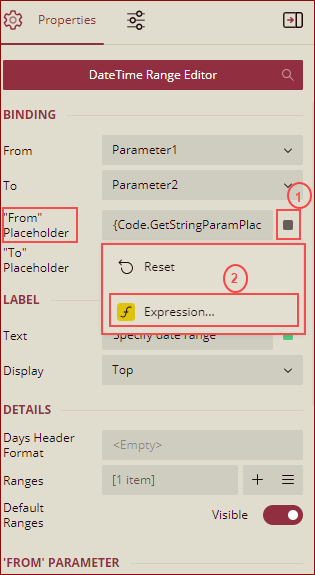
Use the expression for customizing the From Placeholder and To Placeholder.
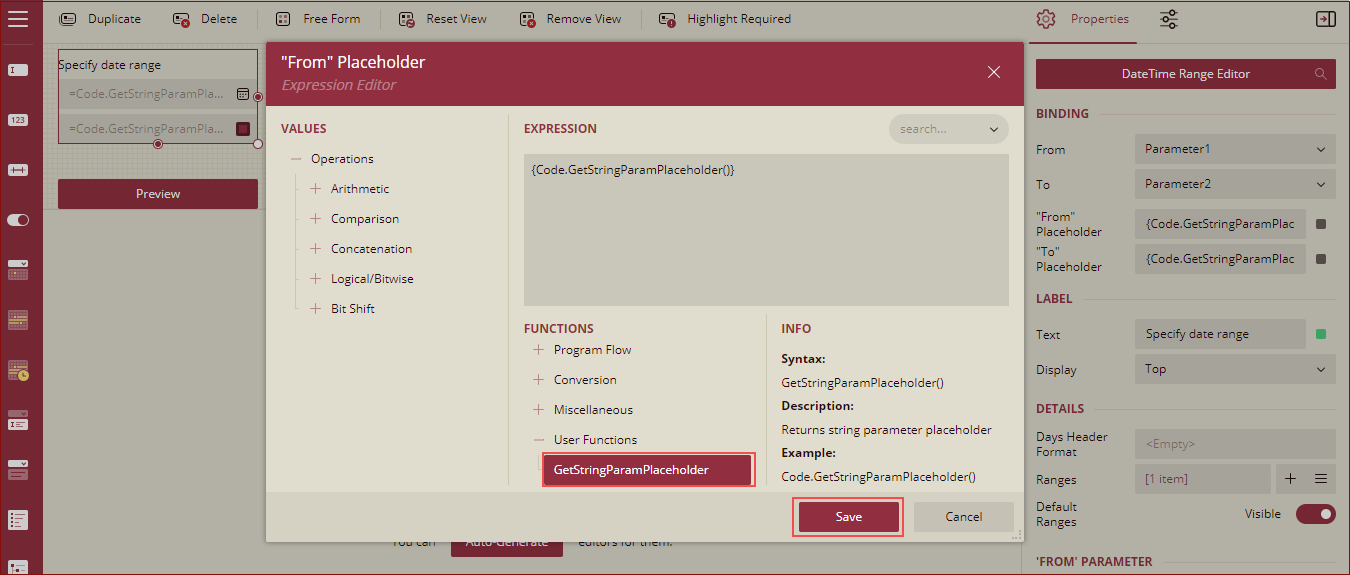
Specify the Label text for the control.
Add a Preview button.

Preview for English.
You can expand the common ranges.
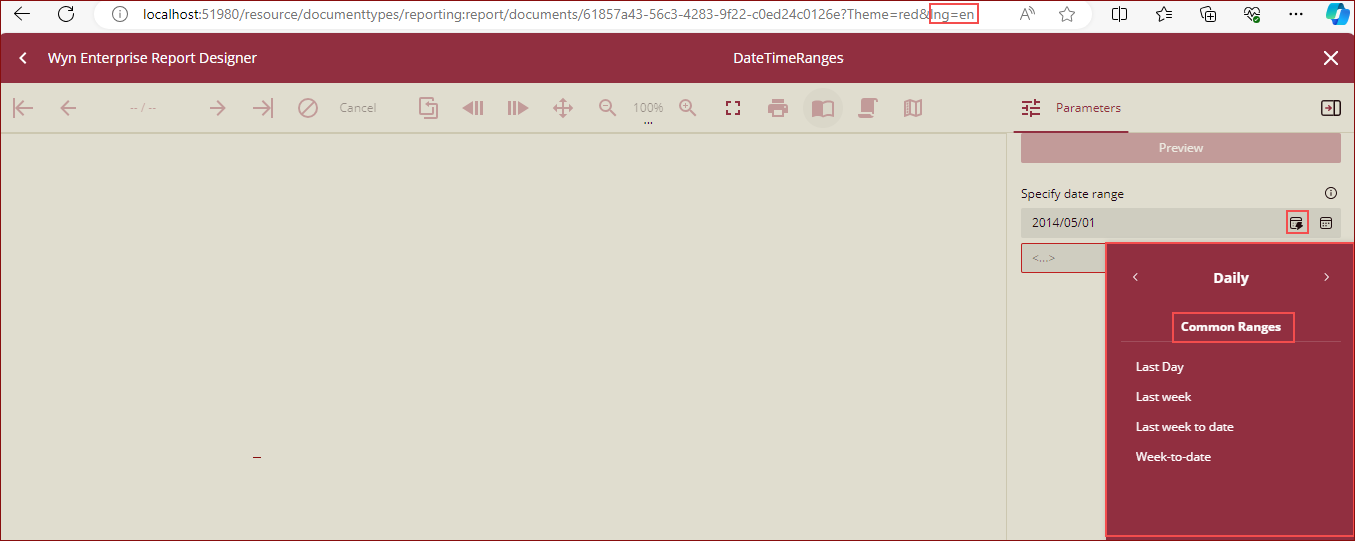
You can expand the calendar.
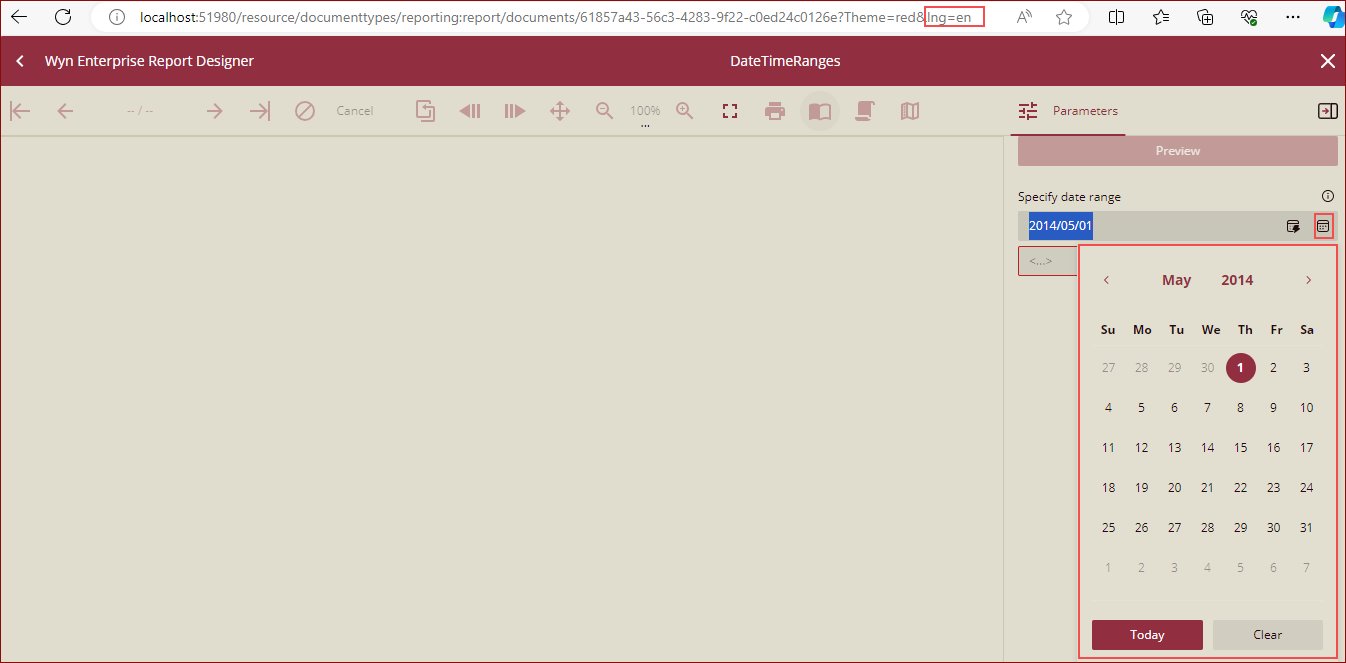
In the URL, change the language key to Chinese simplified language zh-cn as mentioned in the language resource. The placeholders will change to Chinese simplified language as shown below.
You can expand the common ranges.
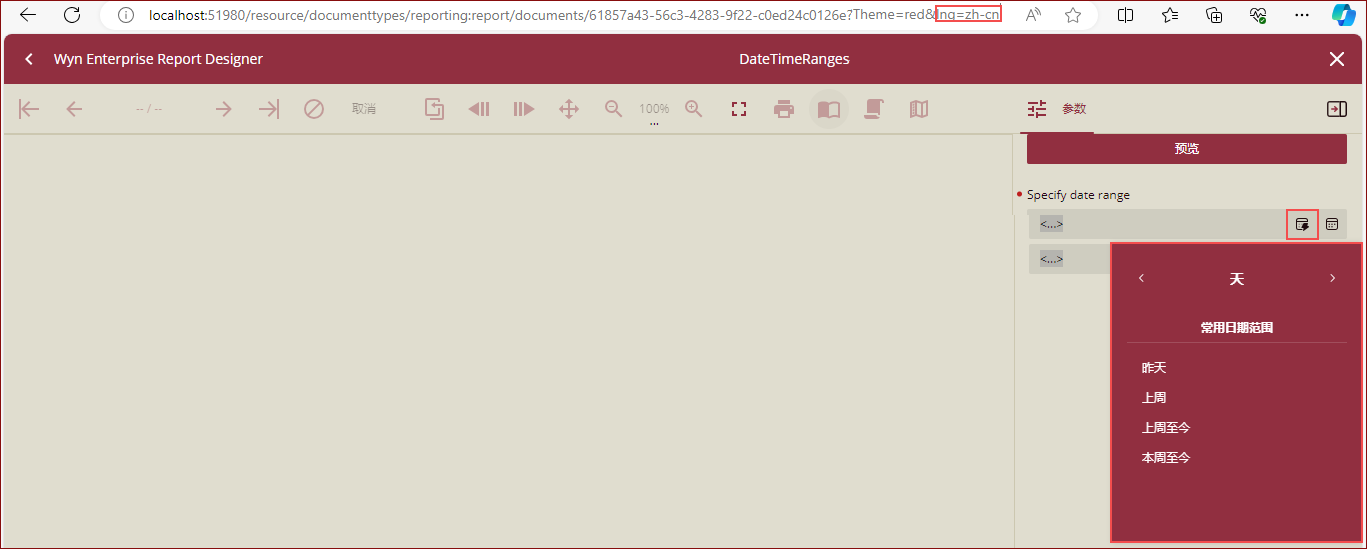
You can expand the calendar.
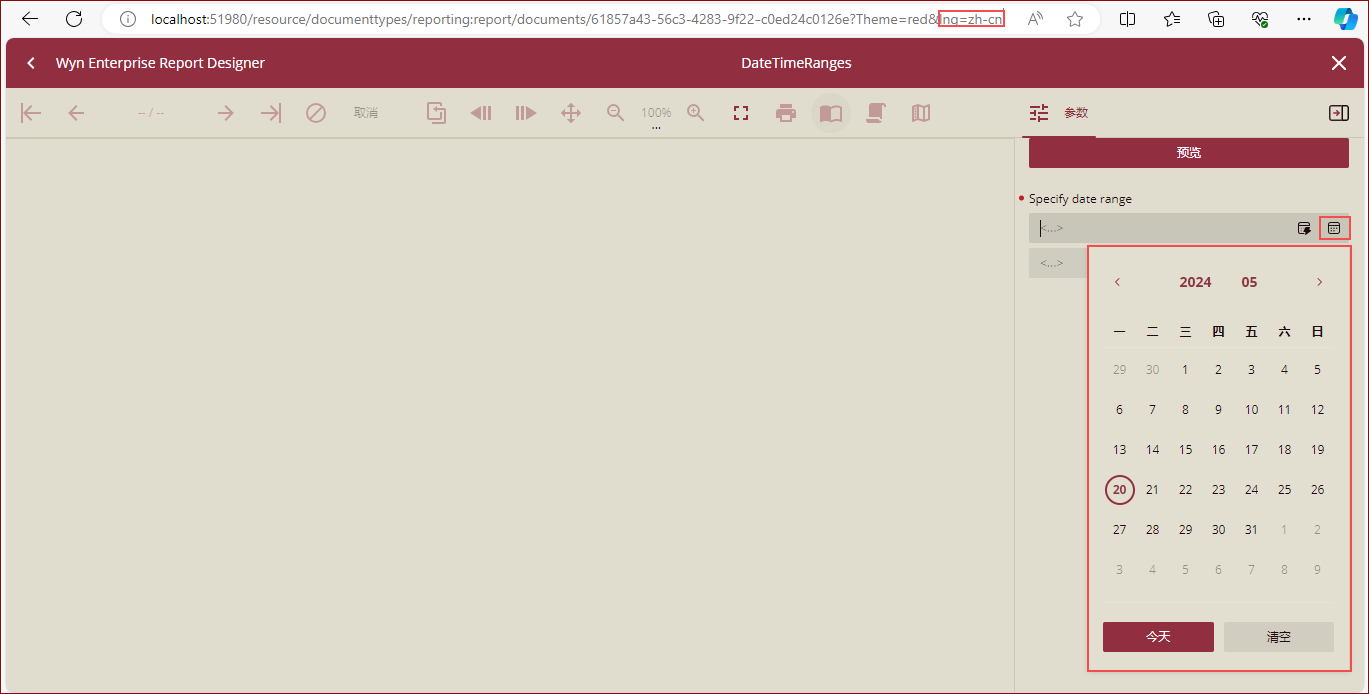
Limiting the Range of Selectable Dates in Date Editors
You can limit the dates in the calendar controller while selecting the dates using the Min and Max properties for the following controls:
DateTime Editor
Date Range Editor
DateTime Range Editor
DateTime Editor Example
In this example, we have taken Parameter 1 as a DateTime parameter and used DateTime Editor in the report's custom parameter view. We have assigned the Min and Max dates for the DateTime Editor as shown below.
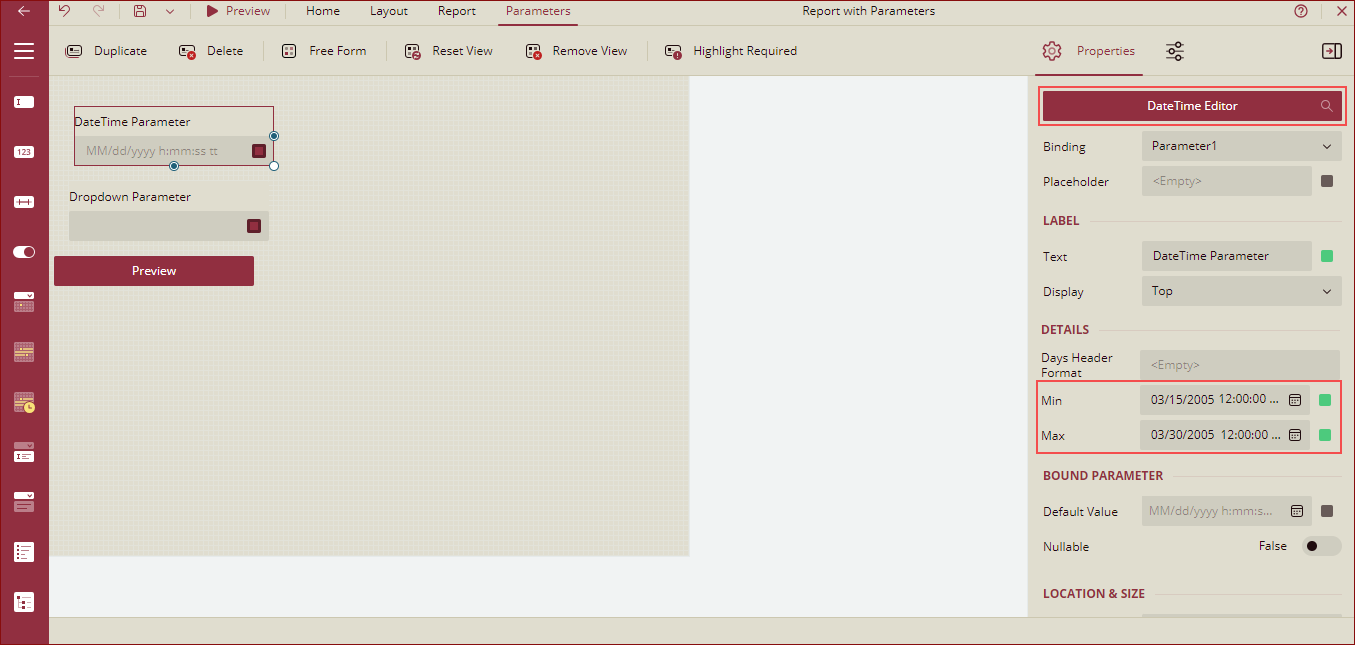
In the preview, you will see that while selecting the dates in the calendar, all the values outside the specified min and max values are disabled, as shown below.
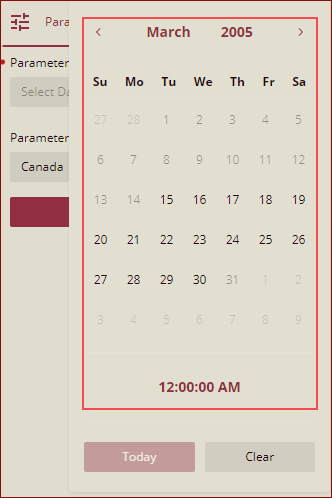
Please note that the following:
If the parameter value is set outside the Min/Max limits, then a red border is displayed around the input as shown below.
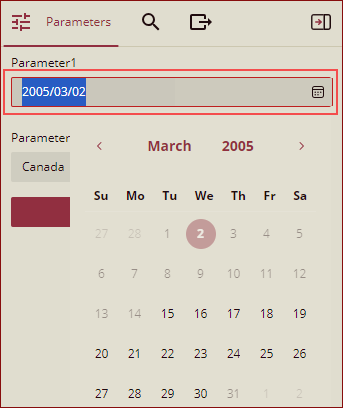
If the Default Value of the parameter is set outside the Min/Max properties, then a red border is displayed around the input as shown below.
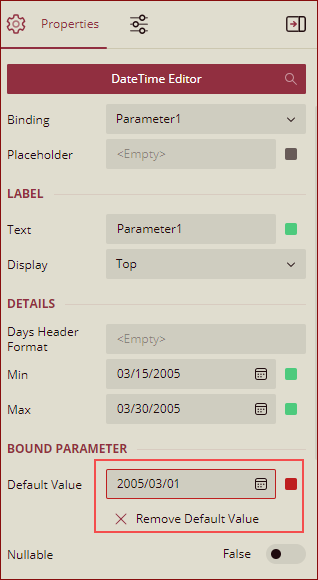
In the case of DateRange/DateTimeRange parameters, the Common Ranges are disabled if they go beyond the Min/Max values, as shown below.
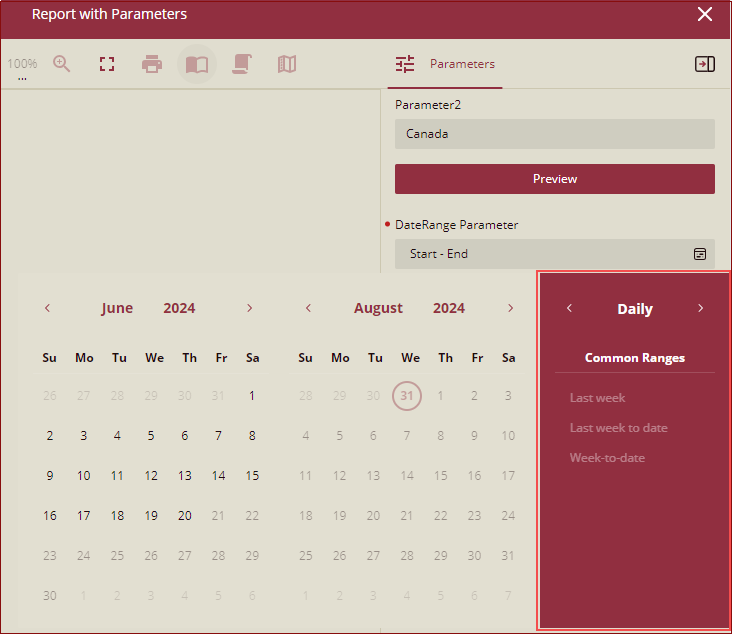
You can add Expression functions for DateTime Editor: Example: Min = 08/7/2024 12:00:00 AM, Max = 08/13/2024 12:00:00 AM, Default Value = {Today()};
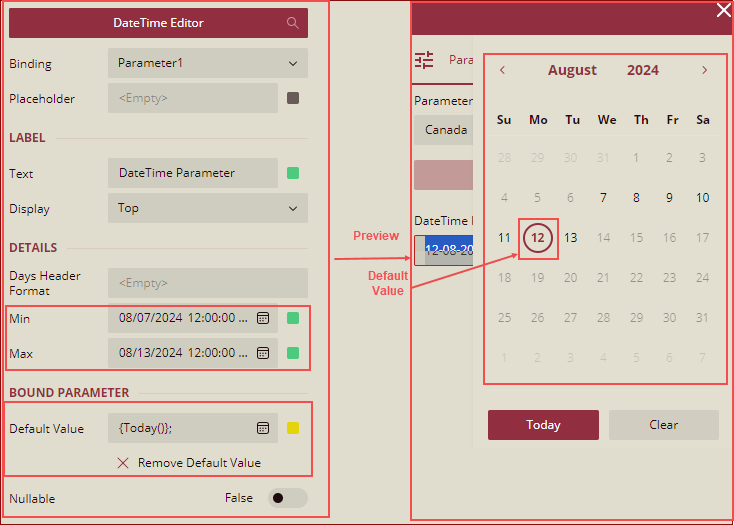
Min/Max properties are displayed in Scheduled Tasks/Document Binder
